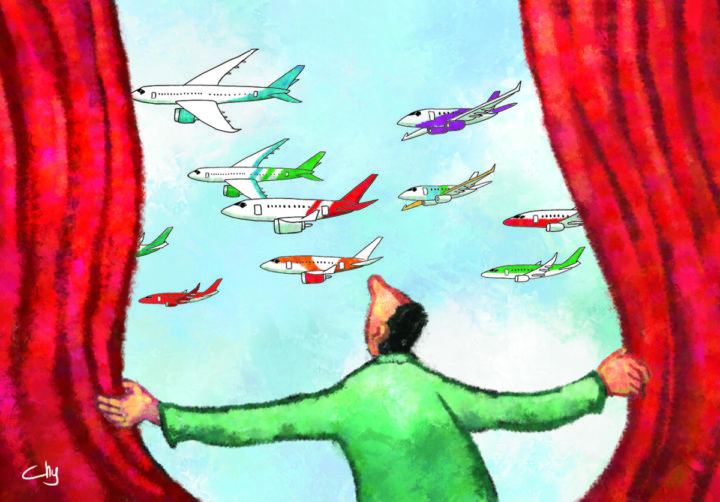
In the last 10-15 years, airplane ticket prices in Indonesia have looked “cheap” and at the same time served by relatively new aircraft.
If in many developed countries flights under 2 or 1 hour are served by propeller aircraft, then in Indonesia, flights under 1 hour mostly use the latest full jet aircraft, with cheap ticket prices. Airline ticket prices are always changing, partly because they adjust to the “busy” or “quiet” season of passengers.
Approaching Eid Al-Fitr, Christmas and New Year, for example, it is certain that ticket prices will soar according to the theory of “supply and demand”. Likewise, nearing the fasting month when the flow of “nyadran” (one of the unique traditions in Indonesia in welcoming the month of Ramadan in the form of cleaning and sowing flowers on ancestral graves) is seen on the surface, ticket prices rise, coincidentally with the increase in aircraft fuel prices, US dollar exchange rate, and tariffs for aviation operations support services.
Casualties
The ticket price hike has angered many parties, including consumers using air transport services, hotel entrepreneurs and tourism services in the regions. The government was forced to intervene. In the midst of negotiations between the government and airlines about inflated ticket prices, unexpectedly the idea emerged about the possibility of inviting foreign airlines to enter Indonesia to serve domestic routes.
This idea was welcomed by a number of parties because it looked very reasonable and would make airline ticket prices competitive. The “low ticket price competition” that occurred in the last two decades will repeat itself.
In this case, it is less realized that the war on low ticket prices—although very successful in spoiling air transport consumers—in reality has taken its toll. Many domestic airlines, including those that have been around for decades, have gone bankrupt.
The number of domestic airlines, which numbered dozens in the early 2000s, has now shrunk to a matter of fingers. All “destroyed” due to the “low ticket price competition” which then gave rise to symptoms of competition for fat route flight slots. The war on low ticket prices has also triggered a fantastic increase in the number of passengers so that many airports are oversized due to the number of passengers exceeding the capabilities of existing service facilities. This condition also gave birth to new “regulations” that were not previously known in the world of aviation, namely the ticket price regulations with an upper and lower limit pattern.
With the number of domestic airlines remaining in a matter of fingers, the land to compete for “low ticket prices” disappears and automatically changes to a pattern of “cooperation” in determining the amount of ticket prices. Furthermore, because it has fallen into the trap of ticket price rules that are in the upper and lower limit tubes, it is inevitable that accusations of “collusion” have occurred in raising airplane ticket prices.
In accordance with the norms of “war” in a multilateral field, when there is nothing to be “destroyed”, the choice is only to make peace and cooperate. In this situation, a “sophisticated” formula has now emerged to reduce airline ticket prices to “cheap” again, namely by inviting foreign airlines to enter to serve domestic routes.
Although it is not easy to be implemented immediately—because there are many considerations that must be considered, among others, because it is against international regulations related to “cabotage” (Article 7 Chicago Convention 1944)— at least this idea will be one of the solutions to be chosen. Whether this formula will work or not, time will tell.
Complete solution
Ideally, before determining the solution that will be taken to solve the problem, it is necessary to conduct an investigation, audit, analysis, or diagnosis of “why” the problem occurred. Once the cause is identified, it will naturally be much easier to choose the most appropriate solution. The analogy is to cure a disease, a doctor will first examine the patient before writing a prescription for a drug that can be purchased at a pharmacy.
This was not done, in the case of the war in low ticket prices in Indonesia. During his journey it was later proven that the ticket price policy with an upper and lower limit did not help solve the problems in the field. What happened was precisely in the era of rampant low fare wars and the fierce struggle for flight slots for this fat route, there were also many airplane accidents and in the end, a number of domestic airlines with quite long operating periods and mature experience went out of business.
At this point, as the cause has never been carefully investigated, we never know whether there is a connection between low ticket prices, the number of plane accidents and the closure of a number of domestic airlines, including Merpati Nusantara Airlines (MNA), the pioneering government airline.
Likewise, we also never knew the main trigger for the increase in the number of passengers at Soekarno-Hatta International (Cengkareng) Airport several years ago, which resulted in severe delays. The solution taken was to simply transfer the excess passengers at Cengkareng Airport to Halim Perdanakusuma International Airport without being based on prior investigation into what caused the passenger explosion.
As a result, a new problem arose at Halim. The collision of a commercial civilian aircraft occurred at Halim Perdanakusuma Air Force Base shortly after the transfer of excess traffic from Cengkareng, namely the Batik Air plane with Transnusa, on April 15, 2016.
Chappy Hakim, Center for the Study of Air Power Indonesia
Source: KOMPAS, June 15, 2019, page 7.
Download the clipping here.



